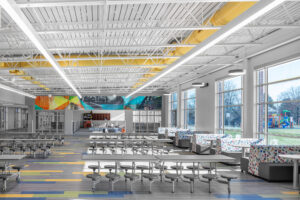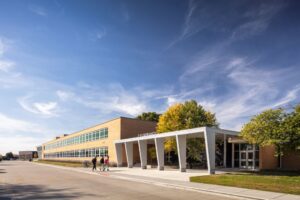
How Does RTM Build Meaningful Partnerships?
What is the foundation of a meaningful design partnership? Does each party need to have the same priorities, the same preferences, the same approach?
These circumstances certainly help, but in our experience in this industry, what matters most are solid connections, clear communication, and mutual education. In this article, I would like to share an example of this type of partnership, our relationship with Legat Architects.
For over a decade, RTM and Legat have collaborated on designs for remodeling and renovating more than three dozen educational facilities in Illinois and Iowa. Our work together spans learning environments from the elementary level through high schools to community colleges.
I recently sat down with Robin Randall, a Legat Principal and the firm’s Director of Learning, to discuss the keys to our prolific, longstanding partnership.
Here are some highlights from that conversation with Robin.
Robin, at RTM we express our values as an acronym, CORE, which stands for Collaborative Communicators, Overall Unity, Respect and Trust, and Excellence in Engineering. I consider the E to include excellence in design, and I feel Legat’s values mirror RTM’s. Do you agree?

Yes, what really connects us is that collaboration and that ability to communicate. I can pick up the phone and call you whether something’s going wrong or when something’s going right, and you will respond.
Legat’s vision statement is “Design that makes a difference.” So, our core values are “stay humble, work hard, and be kind.” And I feel like those values also describe you, Kat. You’re going to give me the grace and the kindness to listen.
Also, you’re not going to ever talk down to me, even though as a mechanical engineer you know far more about [environmental] systems than I do.
I appreciate that. And the best part about working with you is that you lead by example. People want to follow you and put their trust in you. So, I’m confident in our relationship and consider RTM’s core values and Legat’s core values aligned.
Now, Robin, please tell me how you came to Legat.
It’s been a lot of fun. Ten years ago, I was an adjunct professor at Judson University, teaching research and programming classes, and then Judson’s urban design studio, graduate studio…all kinds of design studios.
 There I met Legat’s former Director of Education. We became friends and would co-lecture and collaborate. When he left the organization, he extended an invitation from Legat to replace him.
There I met Legat’s former Director of Education. We became friends and would co-lecture and collaborate. When he left the organization, he extended an invitation from Legat to replace him.
Today, I drive projects and research that brings in work. So, I get to hold the learning umbrella like Mary Poppins. We’ve combined K12 with higher education and libraries under that umbrella.
RTM and Legat use the same term for working groups, design “studios.” Here, each of our offices is considered a department with multiple studios. Tell me about Legat’s approach.
Our studios depend on the people that inhabit them. Personalities drive them.
Our Quad Cities studio [where you’re based] has grown over the last 10 years from two people to 15. It’s a mix of architects and interior designers, as well as business development people. Our headquarters in Chicago has over 25 people. It’s growing, very dynamic and interested in urban design.
Our Ohio studio just celebrated its sixth year, and we just did the Columbus City School’s master plan there.
Around Chicagoland, we have the Oakbrook Studio, which is one of our oldest studios. That’s where I’m based. And then our Gurnee office [in northeast Illinois] also covers Wisconsin projects.
Educator, Professor, Architect, and then your LinkedIn profile calls out Environmentalist… When you were a kid, did you envision having all of these titles?

When I was a kid, I was a busybody, and I still am. When my mom would just get tired of me, she’d be like, “You need to go run a few laps.” And so, I would run around the house because I just had to run off all my energy.
That is just something that is still part of me to this day. I’m more efficient and effective if I’m doing a lot of different things, because one thing informs the other.
[For example] We just discovered this piece of research that’s going to flip the way we think about classrooms…and that’s where the magic is. If you have academia involved, you’re researching and you’re thinking about theory. You can apply that theory to practice and make a difference.
That’s what we’re trying to do. We’re always trying to reinvent the way we do something and make it better, make it more cost-effective, make it more exciting for the users.
And the best thing about working with you is the confidence that I know that you know what you’re doing. Even though you hold leadership positions, you’re still an engineer at heart.
We’re smart people, but I believe what benefits all our clients most is bringing a team together that’s collaborating continuously.
There is much more to my chat with Robin Randall. Hear more of our conversation about meaningful partnerships in this episode of RTM’s Beyond Engineering podcast:
Are you launching a career as an engineering technologist? Or are you a proven professional in the engineering field looking for new ways to advance your career?
Consider joining RTM Engineering Consultants. We support your growth as you sharpen technical skills, deepen business experience and diversify capabilities across services, specialties and markets from coast to coast. Our mentors are seasoned professionals, committed to sharing expertise and passing knowledge from one generation of engineers to the next. Learn why industry authorities consider RTM a great place to work, grow and advance. Explore employment opportunities.

 By:
By: